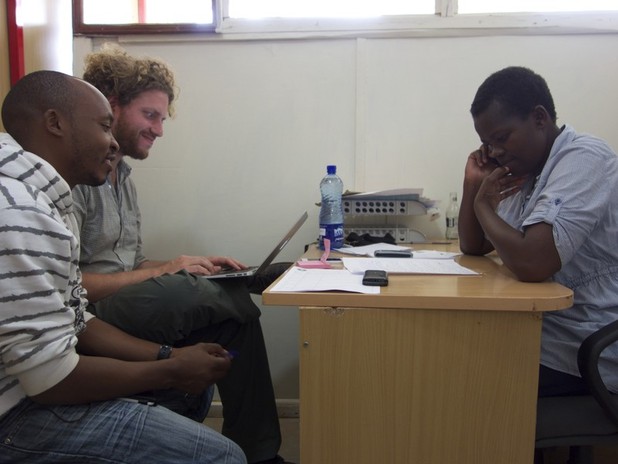
As part of our IDEO.org Innovation Fund, we’re working with Juhudi Kilimo to design new ways to provide technical training for farmers in rural Kenya.
After 10 grueling (but awesome!) days in the field we are returning home with a wealth of knowledge about how information is shared in rural Kenya and some tangible learnings gained from our prototypes in the field.
During our visit, the call center received numerous questions, callers benefited from follow-up calls made by agricultural experts, and farmers were inspired by the informational video. From these two prototypes we learned some valuable lessons.
The Call Center
This first prototype allowed us to gain a basic understanding of some critical elements including: breadth and depth of farmers’ questions, length and complexity of calls, urgency of issues and appropriate timing for call back windows, expertise required for staffing, initial operating costs, and barriers to farmer participation.
During our our human-centered design research, it was identified that experts and farmers alike were skeptical of the effectiveness of a potential call center. However, our call center initial prototype showed that a large percentage of farmer’s questions could easily be answered over the phone and often within minutes. During follow up calls, we asked farmers if their questions had been answered and if they were satisfied with the service. The feedback was overwhelmingly positive as people were delighted to have an expert call them back and point them in the right direction. We were also able to capture a bit of data around pricing as callers said they would definitely pay for the service given it was reasonably priced and if a call back would take place within a timely window.
One big insight we gained was that even when our expert was unable to solve the problem over the phone, she was able to confirm the farmer’s intuition and help them feel more comfortable with spending money to get an in-person expert to visit their farm.
So despite the brevity of our visit and some roadblocks that limited testing pricing and payment in more depth, we feel confident as we move forward that there is a viable and exciting opportunity to pilot this idea. We also see huge potential for the call center to work seamlessly with another idea we prototyped while in the field: farmer-to-farmer videos.
Farmer-to-Farmer Videos
The idea behind this concept is to use videos to proactively disseminate inspiration and information that can help set farmers up for success from the very beginning. In order to prototype the idea we selected a local Kericho farmer and Juhudi borrower, Isaac, to be our star. Isaac and his family are model borrowers and farmers within the community because they have successfully taken a loan to raise hens and now sell the eggs at market.
We structured the video to present a sound business case in the beginning and then give farmers a roadmap for carrying out their own chicken ventures successfully. This means highlighting important financial information that will help farmers operate their ventures as well as helpful tips for caring for assets properly.
We then brought this video to farmer borrower groups to see if Isaac’s story was informative and if the information we highlighted would provide the intended takeaways. The response was incredibly positive and we learned that video is an effective way to help farmers “see it to believe it.” The groups we spoke with also gave us great suggestions about what else might be included in the video, such as setbacks Isaac faced along the way or referrals as to where to find resources.
To connect it back to our first prototype, we gave out the call center number at the end of the video to see how many farmers would be inspired to take action. Our idea here was to promote the call center as not only a tool for solving immediate farming issues, but also as a way to give farmers the necessary information they need at the outset of a new venture, and to show them that the call center can help guide them through that process.
As we move into the final stage of design we feel confident both prototypes have incredible promise for impact. We look forward to keeping you updated as these concepts continue to take shape.
Source publication: IDEO.ORG